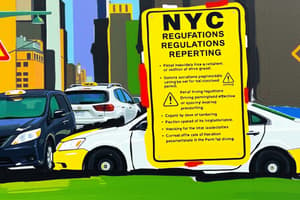Podcast
Questions and Answers
What is a 'closing probability' when driving?
What is a 'closing probability' when driving?
- The chance that the oncoming vehicle on a two-lane roadway will veer into your lane.
- The chance that another vehicle will be in the same place you plan to be at the same time.
- The chance that you will have a crash.
- The chance that a vehicle and another object will move closer together as they move along projected paths of travel. (correct)
Adjusting your speed to address one hazard at a time is called what?
Adjusting your speed to address one hazard at a time is called what?
- Separating (correct)
- Compromising
- Clear path of travel
- Deconflicting
When you are driving, it is most difficult to control the space to your?
When you are driving, it is most difficult to control the space to your?
- Right side
- Rear (correct)
- Left side
- Front
In traffic, the best way to provide an emergency escape path is to maintain adequate space to the?
In traffic, the best way to provide an emergency escape path is to maintain adequate space to the?
When faced with dangers on both sides of your pathway, you should give up more space to the side with?
When faced with dangers on both sides of your pathway, you should give up more space to the side with?
Explain the risk-reduction concept of separating multiple risks and give an example.
Explain the risk-reduction concept of separating multiple risks and give an example.
Explain the risk-reduction concept of compromising among multiple risks and give an example.
Explain the risk-reduction concept of compromising among multiple risks and give an example.
Define 'reasonable and prudent speed.'
Define 'reasonable and prudent speed.'
Identify five common traffic-conflict situations.
Identify five common traffic-conflict situations.
Explain the steps involved in putting the 3- to 4-second following distance rule into practice.
Explain the steps involved in putting the 3- to 4-second following distance rule into practice.
Flashcards are hidden until you start studying
Study Notes
Closing Probability
- Defined as the likelihood that a vehicle and another object will get closer together along projected travel paths.
Adjusting Speed and Separating Risks
- Adjusting speed to address individual hazards is known as separating.
Control of Space While Driving
- The most challenging space to control while driving is the rear.
Emergency Escape Path in Traffic
- To provide an emergency escape path, maintain adequate space in front and at least one side of the vehicle.
Space Management with Dangers
- When dangers are close, give more space to the side with potentially more serious consequences.
Risk-Reduction Concepts
- Separating Risks: Timing is crucial; an example is approaching a narrow bridge.
- Compromising Risks: In scenarios where multiple objects threaten the travel path, wait for the car with the greater risk to pass.
Reasonable and Prudent Speed
- Refers to maintaining a speed that ensures a safe path for travel.
Common Traffic-Conflict Situations
- Oncoming vehicles
- Merging and exiting vehicles
- Vehicles ahead of you
- Vehicles behind you
- Intersecting vehicles and pedestrians
Following Distance Rule
- Implement a 3- to 4-second following distance by selecting a stationary point, counting seconds until the rear of the vehicle in front passes that point, then stopping the count when your vehicle reaches it.
Studying That Suits You
Use AI to generate personalized quizzes and flashcards to suit your learning preferences.



